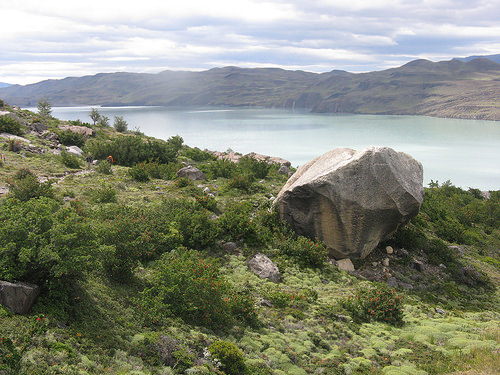From treeline on Cerro Paine, the lunar eclipse Wednesday night was spectacular. After hiking up the sandy mountain in the dark, we pitched our tents on the only slivers of flatness we could find. Then we sat beneath the lenga trees and polished off a box of wine and loaf of marble cake while watching the moon change from a burnt orange globe to nothing to a burnt orange globe again (the pics didn’t do it justice). The wind was too powerful in the morning to ascend an hour and a half to the top of the mountain for sunrise (Gabriel guessed the gusts were 200 mph at the summit), so we just walked a few minutes up from our campsite to a clearing. And, Oh. My. Goodness. For 15 minutes as the sun was rising, we lived in the most golden world I’ve ever seen. The entire landscape, including the towers in the distance, was illuminated. We glowed, so did everything else, and above it all shone a rainbow.
Walkin' the W
Trying to put up a tent in the wind is like trying to walk a big, dumb animal that has an agenda distinctly different from your own. On the first night of my 3.5-day solo-hiking excursion along the Torres del Paine’s legendary W Circuit, my tent wanted to go in the thorny bushes surrounding the campsite — or the lake, it didn’t matter — and I wanted it to go in the nice, flat spot I had picked out in Paine Grande campground.I’m proud to report that after a long, fierce battle, I firmly anchored my opponent to the earth with titanium stakes, and I lined its inside with heavy rocks for extra measure.
Triumph
The W Circuit is approximately 50-kilometer route through Torres del Paine National Park that runs between Grey Glacier the granite towers themselves, ascending the awe-inspiring Valle Frances along the way (forming, oddly enough, a W-shaped route).
A mystic mountain and wind-blown lenga tree I encountered along the trail
For some reason, I wasn’t intimidated by the prospect of taking on the W alone (I didn’t find out about the disappearance of Irish hiker Ronan Lawlor until after I returned). I figured the trails were well marked and I was way more likely to run across a crazy psycho maniac in the hollers of North Carolina than the internationally-visited Torres del Paine. Still, I packed a map and first aid kit, gave Victor in the office my route and asked him to send out a search party if I wasn’t back by Tuesday. I started the hike toward Glacier Grey along the western leg of the W in rain and the 90-km-per-hour winds on Friday morning. The trail ascends a valley, passes the dark-watered Laguna Los Patos and then traces the shoreline of Lago Grey as it approaches the 15-mile-long glacier, one of the largest tongues of the Southern Patagonia Ice Field.
Icebergs in Lago Grey
The still, blue glacier fills the valley it occupies almost to the top, and its edge hugs an island as it meets Lago Grey. The ice field is hard for the eye to comprehend from afar because the sun refracts off it in so many different directions. It registers as a white glow that’s hard to distinguish from the sky. When I crested a hill and first glimpsed it, I inadvertantly gasped and got chills at the same time.
Glaciar Grey and its island
The wind blowing off the glacier is fierce and unrelenting. Despite the rough conditions, though, flowers manage to bloom. I’m impressed by their resiliance.
On Day Numero Dos, I hiked about two hours from the Paine Grande campground to Valle Frances. I pitched my tent at the base of the valley in Campamento Italiano, reserving a spot in the lenga forest right by the river. Then I strapped on a fanny pack (yes, a fanny pack) and ascended the valley, the looming, glacier-ridden Cuerno Paine Grande to my left and the smooth, granite slabs of Los Cuernos to my right.
Los Cuernos from the trail
Let me just say, the view from the mirador at the top of the valley is one of the best in the park: Towering rock formations, including Las Torres in the distance and Los Cuernos more immediately, surround you on all sides. Lucky for me, the ranger who works the Italiano campsite invited another camper and me into his metal-sided shack for dinner. We pooled our pack food, fed the wood-burning stove and created a rich feast of 5-Minute Rice, pasta with red sauce and sauteed hot dogs. As the water boiled, we listened to traditional Chilean music on a set of just-repaired speakers and discussed beehives and garbage. The social interaction was good.
The following day, a warm bed and fluffy comforter thwarted my well-laid plans. I had intended to hike to Refugio Los Cuernos and convince one of the staff members to explore the hidden Valle Bader with me in hopes of touching the base of Los Cuernos themselves and glimpsing the elusive huemul (an endangered deer said to live in the valley). But when the Refugio Cuernos staff offered me a free stay in one of the cozy, A-frame cabins on a hillside overlooking Lake Nordenskjold, I accidentally spent all afternoon napping and reading Jon Krakauer’s “Into the Wild.” It was heaven, really. I helped the Cuernos staff wash dishes in the refugio as a thank-you.
My cabin
After breakfast in the refugio the following morning, I strapped on my pack, extended my hiking poles and took off toward Refugio Las Torres, my home base. The sun was shining, the birdies were chirping and Lago Nordenskjold was blue as ever.
I stepped off of the trail and onto my doorstep, feeling exhilerated by three days in the aire libre of Paine.
Visit this link to see more pics from the hike.













